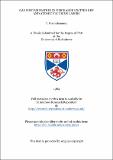Files in this item
Gas contamination in discharge excited KrF and atomic fluorine lasers
Item metadata
| dc.contributor.advisor | Maitland, Arthur | |
| dc.contributor.author | Govindanunny, T. | |
| dc.coverage.spatial | 149, [ca.100] p. | en_US |
| dc.date.accessioned | 2018-06-11T11:27:04Z | |
| dc.date.available | 2018-06-11T11:27:04Z | |
| dc.date.issued | 1984-07 | |
| dc.identifier.uri | https://hdl.handle.net/10023/13891 | |
| dc.description.abstract | This thesis deals with gas contamination problems in atomic fluorine and KrF lasers. Five different versions of transverse electric discharge lasers were constructed using different materials, geometries, and discharge circuits. Three of these were investigated in detail for lifetime performance of a single fill of He-F2 mix (atomic fluorine laser) and of He-Kr-F2 mix (KrF laser). This was done using an on-line quadrupole mass spectrometer. The evolution of the various gas components appearing in the mix was calculated from the mass spectra of the gas mixture recorded at intervals when the laser was operated at one pulse per second. The impurity or contaminant species (ie species other than He, Kr, F2) were found to be the same in all the lasers, differing only in their concentrations. The major contaminants found were CO2, N2, O2, COF2, CF2, SiF4, HF, CO, NO, SF6, and H2O. Of these, CO2 was identified as the most deleterious impurity for both atomic fluorine and KrF lasers, reducing their output energy and the fluorine content, thereby reducing the single fill lifetime of the mix. A simple cold trap decreased the partial pressures of most of the detected impurities in the gas mixture and resulted in a marked increase in the number of shots to half energy and a decrease in the depletion rate of fluorine by half in both KrF and atomic fluorine lasers. To isolate and quantify the effects of individual contaminant species, they were deliberately added singly to the pure gas mix. These experiments confirmed that CO2 was the most important impurity and that H2 and CF4 were the least harmful. Since the impurities were found to influence arcing of the discharge, they must affect preionization and/or discharge processes. Absorption effects were found to be insignificant in the regions of the laser wavelengths (248 nm, 730 nm). In order to quantify the effect of the impurities an effectiveness constant for each contaminant has been defined and used in a simple model which successfully calculates the laser output energy. This model has circumvented the problems arising from the physical complexity of the system and the lack of data on the various kinetic processes. The calculations show that CO2 impurity depletes the energy output of the KrF laser at the rate of 0.9 mJ/ppt(wrt He). | en_US |
| dc.language.iso | en | en_US |
| dc.publisher | University of St Andrews | |
| dc.subject.lcc | TK7871.35G7 | |
| dc.subject.lcsh | Gas lasers | |
| dc.title | Gas contamination in discharge excited KrF and atomic fluorine lasers | en_US |
| dc.type | Thesis | en_US |
| dc.contributor.sponsor | University of St Andrews. Research Scholarship | en_US |
| dc.type.qualificationlevel | Doctoral | en_US |
| dc.type.qualificationname | PhD Doctor of Philosophy | en_US |
| dc.publisher.institution | The University of St Andrews | en_US |
This item appears in the following Collection(s)
Items in the St Andrews Research Repository are protected by copyright, with all rights reserved, unless otherwise indicated.

